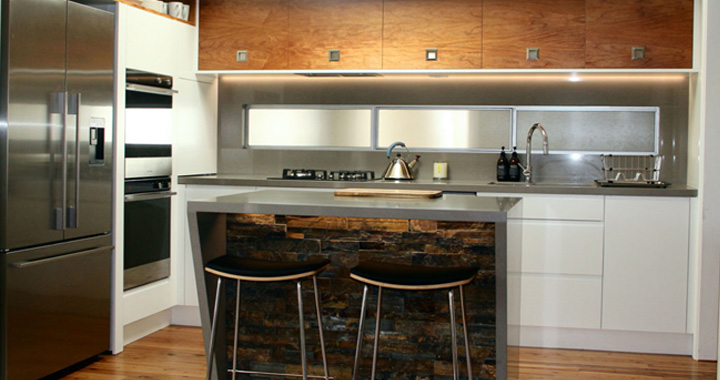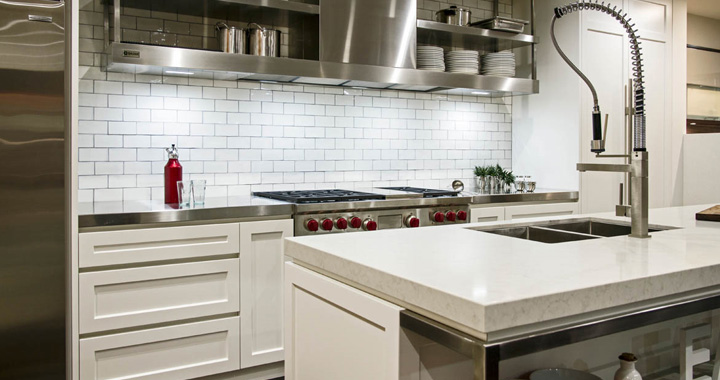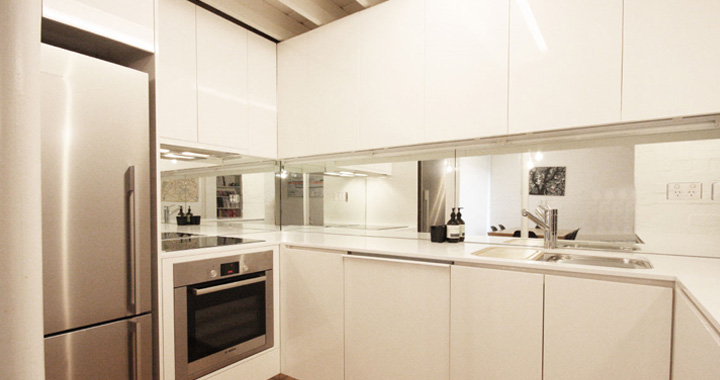Thinking outside the box
Kitchen Cabinet Design – All the Possibilities
Let’s do a little exercise. Go to your kitchen for a moment and take a look around you – what is the most significant item you see? In most cases, it will be the kitchen cabinets that enclose the space as if they are marking and defining their territory. The kitchen requires careful attention with respect to planning and design, its style creates an aesthetic statement, and the location of the cabinets with respect to the other components and appliances determines the flow in the space.
Planning According to Needs
Kitchen cabinets are at the heart of this important space. They are responsible for storing utensils, they are used as food pantries, and they provide a space to display decorative dishes. Kitchen cabinets that are designed correctly serve as a practical and aesthetic asset for years. In matching cabinets and their inner sections you must address several factors: the nature of kitchen conduct (cooking hours, lifestyle), the people typically stirring the cauldron (single tenant, couple, family with kids) and more. Characteristics such as height, depth, shape of the opening, sliding drawers, baskets, safety locks and so on, are the elements that dictate the internal design of the cabinets – and therefore it is important to think about all the details in advance.

Photo: Itay Sikolsky
The “10 Golden Questions” for Planning your Kitchen Cabinets
In order to be organized and to focus your considerations, her are ten central questions you need to consider when planning your next kitchen.
- How much was your triangle of kitchen operations (the lines connecting the sink, stove and refrigerator) carefully planned? This work triangle produces a majority of the activity, and therefore should not spread too far.
- How accurate were the measurements of your kitchen space that were presented before the kitchen designer? Incorrect measurements will produce cabinets that do not fit or extra spaces that are difficult to fill during the execution stage.
- Are you interested in customized kitchen cabinets or kitchen cabinets from the showcase? Customized kitchen cabinets require planning that takes time and professionals, but they are customized to the homeowners and their needs. However, in most cases, the cost of a kitchen from a “showcase” will be relatively low. The trial experience is ideal as you can already check the level of practicality from the displays at the store, examine the raw materials, the manner in which it is put together, and of course, get a first impression of the design.
- Are you familiar with the advantages and disadvantages of the possible raw materials for kitchen cabinets – various types of wood, MDF, sandwich boards, particle board and the like? Take into consideration that the outside and inside of the cabinets are not necessarily made of the same raw material.
- Will your kitchen cabinets contain staples or just screws? The quality of the connection between the parts will determine the amount of wear on the cabinets over time.
- What about fixtures? The convenience of opening and closing the kitchen cabinets is very important, not just the design element in selecting kitchen fixtures. Additionally, the quality of the materials and assembly will determine the durability of the cabinets for the long term and will impact the convenience of the work.
- What about product warranty? To which address will you refer when the need will arise? It is important to check the reservations and “fine print” with respect to materials that tend to erode and to know in advance the limits of liability of the manufacturer or assembler. For example – with the installation of surfaces and cladding by a Caeserstone company, you are granted a three-year warranty from the date of installation, provided that the installation is performed by a licensed processor.
- What safety measures have been taken as part of the kitchen planning? For houses with small children, safety locks should be considered, cabinets should have fixtures and handles that will not turn into a “ladder” for the kids to reach the counter and stove, and doors should close with mechanisms that prevent the occasional slamming of the finger.
- Is a toe kick included in the kitchen cabinet design? A toe kick is a unit that is situated at the bottom of the cabinets, perpendicular to the ground. For most, the height of the toe kick is about fifteen centimeters and its role is to protect the cabinets from penetrating liquids and collecting dirt. In the process of planning the kitchen cabinets it is important to check the durability of the materials from which it is made and how convenient it is to dismantle for thorough cleaning.
- From which materials will the cladding be made for the façade? It is important to recognize the differences between the common materials – marble, Caesarstone, melamine, veneer, Formica, glass, acrylic material or wood. You should think carefully about the design aspects and practical aspects of each of the materials, to what extent they erode, how easy they are to clean, etc.
Taking the Box Apart – from what is a kitchen cabinet made?
Kitchen cabinets are constructed from body of the cabinet and the facade of the cabinet. For the most part, the materials from which the body is made are particle board (tiny wood fibers processed together with the addition of glue) or sandwich board that is made from layers of wood glued together. These are called industrial woods and their quality depends on the type of glue and the density of the materials from which they are made. MDF particle board is typically used for the inside of the drawers.
When speaking of doors and their external coating – the range can be exhausting. Here we can find, for example, solid wood or Formica / melamine / stainless steel / veneer finish, a kitchen cabinet with its body made of sandwich board and a veneer external finish with drawers with a bottom. MDF is not recommended for the body of the cabinet made of solid wood as the raw material is more expensive and in many cases cannot survive the natural humidity that exists in the kitchen and can distort due to frequent temperature changes.
There is a wide range of materials for the facade of the cabinet and a multitude of designs which of course can significantly upgrade the appearance of the kitchen. Among the available materials for the facades of the kitchen cabinets -
- Caesarstone quartz cladding: Today, using advanced technology, it is possible to cover the kitchen cabinets using Caesarstone quartz surfaces, which provide a decorative marble appearance. These unique claddings are available in a variety of textures, colors and finishes. These are especially thin surfaces, up to a thickness of only 3mm that do not weigh on the body of the cabinets and allow for easy opening and closing of the doors.
- Formica cladding: The surface is made of processed plastic fibers in a mixture of hardness that are glued onto plywood (industrial wood made of compressed wood chips). The result is smooth to the touch with a glazed finish.
- Veneer cladding: A thin layer of wood glued on to an MDF board. The design varies according to the level of shine and preferred texture (“natural wood” look, stripes, and more).
Solid wood layers (walnut, oak, cherry, beech, maple and more) – these layers are glued together forming a grid which produces a quality product for the long term. - Glass: Takes up more and more room in the kitchen design with textures, the degree of polish and range of prints. The glass is primarily used for the upper kitchen cabinets.
5 Signs of Quality Kitchen Cabinets
- Closed doors are aligned with consistent intervals between them
- High degree of polishing (on the exterior and interior)
- Doors and drawers close quietly
- High degree of finish on the surfaces (without bubbles, leaks or drops)
- Fixtures are fastened correctly (including the lift-up door to the kitchen)
Upper and Lower Kitchen Cabinets
The upper cabinets constitute a significant part of the kitchen design. It is important to consider all the possible opening forms. The grip of the handles must be comfortable in order to allow for quick and easy maneuvering (regular opening, lift-up), as well as to take into account the heights of the “customers” who would be cooking in the kitchen.
Lower cabinets include, among other things, a space for a dishwasher, oven, etc. Proper planning of lower cabinets should take into consideration the size and location of electrical appliances and produce a design harmonious to the eye. Typically, the lower cabinets are deeper than the upper cabinets and access to the lower cabinets will be less convenient. Corner cabinets are even trickier however there are a range of advanced solutions for them in the market. It is important to accessorize the cabinet with quality and convenient sliding drawers or other design solutions that meet the need for easy accessibility. Drawers will enable you to optimize the cabinet space so that you can store a number of items one next to the other and their accessibility will be easier.
Renewing Existing Kitchen Cabinets
Almost any kitchen cabinet can be renewed and refreshed. Remodeling or renewing kitchen cabinets sometimes include external design changes only and sometimes it consists of a complete reorganizing of the shelves, replacing hinges, adding carousels/baskets, replacing tracks for the drawers, etc. Replacing the cabinet fixtures upgrades the appearance instantly and with a relatively minimal investment.
Painting the kitchen cabinets can be done using durable materials tailored for easy routine maintenance, that do not contain lead which is a toxic substance that you do not want near your food. Opaque paints allow for changing colors, as opposed to acrylic-based varnishes which preserve the existing appearance, protect it and refresh the look. Consider the possibility of painting the exterior of your cabinets with an oven-baked epoxy-based material. The oven-baked painting process ensures high consistency and durability of the paint.
Trends in Kitchen Cabinet Design
Lift-up Doors – Lift-up doors to the kitchen are doors outfitted with an advanced fixture mechanism for opening upwards or sideways. Lift-up doors for the kitchen are especially suited for lofted kitchen cabinets and they can be produced from exterior cabinets made of quartz, glass or solid wood combined with Formica.

Photography: Webb Brown Neaves
From the website: Caesarstone Australia
Eclecticism - Eclecticism can be expressed in different combinations of materials, textures, and color. The combination of materials, especially in classic kitchen design, creates interest and draws the eye, thereby upgrading the entire room.

Photography: Matt Michael Design
From the website: Caesarstone Australia
Integration of Electrical Appliances – One of the common trends in kitchen cabinet design is that of covering the electrical appliances. To do this, we recommend, already in the planning stage, to know which appliances you plan to use and their measurements. This is in order for you to be able to build kitchen cabinets customized for them.

Photography: George Skentzos: Kastell Kitchens Australia
Incorporating Vitrines – Kitchen cabinets with glass exteriors, such as a vitrine, allow for the eye to rest from the “heaviness” of the appearance of closed wall to wall cabinets. A few glass exteriors alone allow for a pleasant display of dishes or decorative items in the kitchen and give the appearance of a stylish piece of furniture for the entire cabinet system.
Photography: Itay Sikolsky
Smart Storage – Today, more than ever, there is a high awareness of the importance every available centimeter of space in the kitchen. By means of customized smart storage, it is possible to efficiently use the highest and deepest corners in your kitchen.
